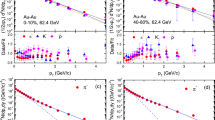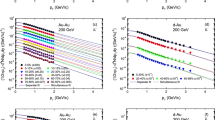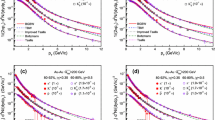Abstract
The transverse momentum distributions of the identified particles produced in small collision systems at the Relativistic Heavy Ion Collider (RHIC) and Large Hadron Collider (LHC) have been analyzed by four models. The first two models utilize the blast-wave model with different statistics. The last two models employ certain linear correspondences based on different distributions. The four models describe the experimental data measured by the Pioneering High Energy Nuclear Interaction eXperiment, Solenoidal Tracker at RHIC, and A Large Ion Collider Experiment collaborations equally well. It is found that both the kinetic freeze-out temperature and transverse flow velocity in the central collisions are comparable with those in the peripheral collisions. With the increase of collision energy from that of the RHIC to that of the LHC, the considered quantities typically do not decrease. Comparing with the central collisions, the proton–proton collisions are closer to the peripheral collisions.









Similar content being viewed by others
References
J. Cleymans, H. Oeschler, K. Redlich et al., Comparison of chemical freeze-out criteria in heavy-ion collisions. Phys. Rev. C 73, 034905 (2006). https://doi.org/10.1103/PhysRevC.73.034905
A. Andronic, P. Braun-Munzinger, J. Stachel, Hadron production in central nucleus–nucleus collisions at chemical freeze-out. Nucl. Phys. A 772, 167 (2006). https://doi.org/10.1016/j.nuclphysa.2006.03.012
A. Andronic, P. Braun-Munzinger, J. Stachel, Thermal hadron production in relativistic nuclear collisions. Acta Phys. Pol. B 40, 1005 (2009). arXiv:0901.2909 [nucl-th]
A. Andronic, P. Braun-Munzinger, J. Stachel, The horn, the hadron mass spectrum and the QCD phase diagram—the statistical model of hadron production in central nucleus-nucleus collisions. Nucl. Phys. A 834, 237c (2010). https://doi.org/10.1016/j.nuclphysa.2009.12.048
S. Chatterjee, S. Das, L. Kumar et al., Freeze-out parameters in heavy-ion collisions at AGS, SPS, RHIC, and LHC energies. Adv. High Energy Phys. 2015, 349013 (2015). https://doi.org/10.1155/2015/349013
E. Schnedermann, J. Sollfrank, U. Heinz, Thermal phenomenology of hadrons from 200\(A\) GeV S+S collisions. Phys. Rev. C 48, 2462 (1993). https://doi.org/10.1103/PhysRevC.48.2462
B.I. Abelev et al., (STAR Collaboration), Systematic measurements of identified particle spectra in pp, d+Au, and Au+Au collisions at the STAR detector. Phys. Rev. C 79, 034909 (2009). https://doi.org/10.1103/PhysRevC.79.034909
B.I. Abelev et al., (STAR Collaboration), Identified particle production, azimuthal anisotropy, and interferometry measurements in Au+Au collisions at \(\sqrt{s_{\text{NN}}}=\) 9.2 GeV. Phys. Rev. C 81, 024911 (2010). https://doi.org/10.1103/PhysRevC.81.024911
Z.B. Tang, Y.C. Xu, L.J. Ruan et al., Spectra and radial flow in relativistic heavy ion collisions with Tsallis statistics in a blast-wave description. Phys. Rev. C 79, 051901(R) (2009). https://doi.org/10.1103/PhysRevC.79.051901
S. Takeuchi, K. Murase, T. Hirano et al., Effects of hadronic rescattering on multistrange hadrons in high-energy nuclear collisions. Phys. Rev. C 92, 044907 (2015). https://doi.org/10.1103/PhysRevC.92.044907
H. Heiselberg, A.M. Levy, Elliptic flow and Hanbury–Brown–Twiss in noncentral nuclear collisions. Phys. Rev. C 59, 2716 (1999). https://doi.org/10.1103/PhysRevC.59.2716
U.W. Heinz, Lecture Notes for Lectures Presented at the 2nd CERN-Latin-American School of High-Energy Physics, June 1–14, 2003 (San Miguel Regla, Mexico, 2004). arXiv:hep-ph/0407360
R. Russo, Measurement of \(D^+\) meson production in p–Pb collisions with the ALICE detector, Ph.D. thesis (Universita degli Studi di Torino, Italy, 2015). arXiv:1511.04380 [nucl-ex]
H.-L. Lao, F.-H. Liu, B.-C. Li, Kinetic freeze-out temperatures in central and peripheral collisions: which one is larger? Nucl. Sci. Tech. 29, 82 (2018). https://doi.org/10.1007/s41365-018-0425-x
H.-R. Wei, F.-H. Liu, R.A. Lacey, Kinetic freeze-out temperature and flow velocity extracted from transverse momentum spectra of final-state light flavor particles produced in collisions at RHIC and LHC. Eur. Phys. J. A 52, 102 (2016). https://doi.org/10.1140/epja/i2016-16102-6
H.-L. Lao, H.-R. Wei, F.-H. Liu, An evidence of mass-dependent differential kinetic freeze-out scenario observed in Pb–Pb collisions at 2.76 TeV. Eur. Phys. J. A 52, 203 (2016). https://doi.org/10.1140/epja/i2016-16203-2
H.-R. Wei, F.-H. Liu, R.A. Lacey, Disentangling random thermal motion of particles and collective expansion of source from transverse momentum spectra in high energy collisions. J. Phys. G 43, 125102 (2016). https://doi.org/10.1088/0954-3899/43/12/125102
J. Cleymans, D. Worku, Relativistic thermodynamics: transverse momentum distributions in high-energy physics. Eur. Phys. J. A 48, 160 (2012). https://doi.org/10.1140/epja/i2012-12160-0
H. Zheng, L.L. Zhu, Comparing the Tsallis distribution with and without thermodynamical description in p+p collisions. Adv. High Energy Phys. 2016, 9632126 (2016). https://doi.org/10.1155/2016/9632126
A. Adare et al., (PHENIX Collaboration), Spectra and ratios of identified particles in Au+Au and d+Au collisions at \(\sqrt{s_{\text{ NN}}}=\) 200 GeV. Phys. Rev. C 88, 024906 (2013). https://doi.org/10.1103/PhysRevC.88.024906
J. Adams et al., (STAR Collaboration), Identified hadron spectra at large transverse momentum in p+p and d+Au collisions at \(\sqrt{s_{\text{ NN}}}=\) 200 GeV. Phys. Lett. B 637, 161 (2006). https://doi.org/10.1016/j.physletb.2006.04.032
G. Agakishiev et al., (STAR Collaboration), Identified hadron compositions in p+p and Au+Au collisions at high transverse momenta at \(\sqrt{s_{\text{ NN}}}=\) 200 GeV. Phys. Rev. Lett. 108, 072302 (2012). https://doi.org/10.1103/PhysRevLett.108.072302
J. Adams, (STAR Collaboration), Pion, kaon, proton and anti-proton transverse momentum distributions from p+p and d+Au collisions at \(\sqrt{s_{\text{ NN}}}=\) 200 GeV. Phys. Lett. B 616, 8 (2005). https://doi.org/10.1016/j.physletb.2005.04.041
J. Adam et al., (ALICE Collaboration), Multiplicity dependence of charged pion, kaon, and (anti)proton production at large transverse momentum in p–Pb collisions at \(\sqrt{s_{\text{ NN}}}=\) 5.02 TeV. Phys. Lett. B 760, 720 (2016). https://doi.org/10.1016/j.physletb.2016.07.050
B. Abelev et al., (ALICE Collaboration), Production of charged pions, kaons and protons at large transverse momenta in \(pp\) and Pb–Pb collisions at \(\sqrt{s_{\text{ NN}}}=\) 2.76 TeV. Phys. Lett. B 736, 196 (2014). https://doi.org/10.1016/j.physletb.2014.07.011
R. Odorico, Does a transverse energy trigger actually trigger on large-\(p_T\) jets? Phys. Lett. B 118, 151 (1982). https://doi.org/10.1016/0370-2693(82)90620-7
G. Arnison et al., (UA1 Collaboration), Transverse momentum spectra for charged particles at the CERN proton–antiproton collider. Phys. Lett. B 118, 167 (1982). https://doi.org/10.1016/0370-2693(82)90623-2
T. Mizoguchi, M. Biyajima, N. Suzuki, Analyses of whole transverse momentum distributions in \({\rm p}{\bar{p}}\) and pp collisions by using a modified version of Hagedorn’s formula. Int. J. Mod. Phys. A 32, 1750057 (2017). https://doi.org/10.1142/S0217751X17500579
http://www.phenix.bnl.gov/WWW/show_plot.php.html, quoted from ref. [19] (which shows the web page) in P. Guptaroy, G. Sau, S.K. Biswas, S. Bhattacharyya, Understanding the characteristics of multiple production of light hadrons in Cu+Cu interactions at various RHIC energies: a model-based analysis. Nuovo Cimento B 125, 1071 (2010). 10.1393/ncb/i2010-10913-4, arXiv:0907.2008v2 [hep-ph]
B.I. Abelev et al., (STAR Collaboration), Spectra of identified high-\(p_T\) \(\pi ^{\pm }\) and p(\(\rm \bar{p}\)) in Cu+Cu collisions at \(\sqrt{s_{\text{ NN}}}=\) 200 GeV. Phys. Rev. C 81, 054907 (2010). https://doi.org/10.1103/PhysRevC.81.054907
E.K.G. Sarkisyan, A.S. Sakharov, Multihadron production features in different reactions. AIP Conf. Proc. 828, 35 (2006). https://doi.org/10.1063/1.2197392
E.K.G. Sarkisyan, A.S. Sakharov, Relating multihadron production in hadronic and nuclear collisions. Eur. Phys. J. C 70, 533 (2010). https://doi.org/10.1140/epjc/s10052-010-1493-1
A.N. Mishra, R. Sahoo, E.K.G. Sarkisyan, Effective-energy budget in multiparticle production in nuclear collisions. Eur. Phys. J. C 74, 3147 (2014). https://doi.org/10.1140/epjc/s10052-015-3275-2. and Erratum. Eur. Phys. J. C 75 70 (2015). https://doi.org/10.1140/epjc/s10052-014-3147-1
E.K.G. Sarkisyan, A.N. Mishra, R. Sahoo et al., Multihadron production dynamics exploring the energy balance in hadronic and nuclear collisions. Phys. Rev. D 93, 054046 (2016). https://doi.org/10.1103/PhysRevD.93.054046 and Addendum. Phys. Rev. D 93, 079904 (2016). https://doi.org/10.1103/PhysRevD.93.079904
E.K.G. Sarkisyan, A.N. Mishra, R. Sahoo et al., Centrality dependence of midrapidity density from GeV to TeV heavy-ion collisions in the effective-energy universality picture of hadroproduction. Phys. Rev. D 94, 011501(R) (2016). https://doi.org/10.1103/PhysRevD.94.011501
C. Patrignani et al., (Particle data group), Review of particle physics. Chin. Phys. C 40, 100001 (2016). https://doi.org/10.1088/1674-1137/40/10/100001
F.-H. Liu, Y.-Q. Gao, B.-C. Li, Comparing two-Boltzmann distribution and Tsallis statistics of particle transverse momentums in collisions at LHC energies. Eur. Phys. J. A 50, 123 (2014). https://doi.org/10.1140/epja/i2014-14123-9
A.N. Tawfik, Axiomatic nonextensive statistics at NICA energies. Eur. Phys. J. A 52, 253 (2016). https://doi.org/10.1140/epja/i2016-16253-4
A.N. Tawfik, H. Yassin, E.R.A. Elyazeed, On thermodynamic self-consistency of generic axiomatic-nonextensive statistics. Chin. Phys. C 41, 053107 (2017). https://doi.org/10.1088/1674-1137/41/5/053107
A.N. Tawfik, Lattice QCD thermodynamics and RHIC-BES particle production within generic nonextensive statistics. Phys. Part. Nucl. Lett. (PEPAN) 15, 199 (2018). https://doi.org/10.1134/S1547477118030196
J.D. Bjorken, Highly relativistic nucleus–nucleus collisions: the central rapidity region. Phys. Rev. D 27, 140 (1983). https://doi.org/10.1103/PhysRevD.27.140
K. Okamoto, C. Nonaka, A new relativistic viscous hydrodynamics code and its application to the Kelvin–Helmholtz instability in high-energy heavy-ion collisions. Eur. Phys. J. C 77, 383 (2017). https://doi.org/10.1140/epjc/s10052-017-4944-0
H.C. Song, Y. Zhou, K. Gajdošová, Collective flow and hydrodynamics in large and small systems at the LHC. Nucl. Sci. Tech. 28, 99 (2017). https://doi.org/10.1007/s41365-017-0245-4
S. Das (for the STAR Collaboration), Identified particle production and freeze-out properties in heavy-ion collisions at RHIC beam energy scan program. EPJ Web Conf. 90, 08007 (2015). https://doi.org/10.1051/epjconf/20159008007
S. Das (for the STAR Collaboration), Centrality dependence of freeze-out parameters from the beam energy scan at STAR. Nucl. Phys. A 904–905, 891c (2013). https://doi.org/10.1016/j.nuclphysa.2013.02.158
L. Adamczyk et al., (STAR Collaboration), Bulk properties of the medium produced in relativistic heavy-ion collisions from the beam energy scan program. Phys. Rev. C 96, 044904 (2017). https://doi.org/10.1103/PhysRevC.96.044904
X.F. Luo, Exploring the QCD phase structure with beam energy scan in heavy-ion collisions. Nucl. Phys. A 956, 75 (2016). https://doi.org/10.1016/j.nuclphysa.2016.03.025
C. Markert (for the STAR Collaboration), Resonance production in heavy-ion collisions at STAR. J. Phys. G 35, 044029 (2008). https://doi.org/10.1088/0954-3899/35/4/044029
I. Melo, B. Tomášik, Reconstructing the final state of Pb+Pb collisions at \(\sqrt{s_{\text{ NN}}}=\) 2.76. TeV. J. Phys. G 43, 015102 (2016). https://doi.org/10.1088/0954-3899/43/1/015102
A. Iordanova, (for the STAR Collaboration), Strangeness and bulk freeze-out properties at RHIC. J. Phys. G 35, 044008 (2008). https://doi.org/10.1088/0954-3899/35/4/044008
A. Iordanova, (for the STAR Collaboration), O. Barannikova, R. Hollis, System size dependence of freeze-out properties at RHIC. Int. J. Mod. Phys. E 16, 1800 (2007). https://doi.org/10.1142/S0218301307007027
A. Ortiz, G. Bencédi, H. Bello, Revealing the source of the radial flow patterns in proton–proton collisions using hard probes. J. Phys. G 44, 065001 (2017). https://doi.org/10.1088/1361-6471/aa6594
S.S. Adler et al., (PHENIX Collaboration), Identified charged particle spectra and yields in Au+Au collisions at \(\sqrt{s_{NN}}=\) 200 GeV. Phys. Rev. C 69, 034909 (2004). https://doi.org/10.1103/PhysRevC.69.034909
S. Chatterjee, B. Mohanty, R. Singh, Freezeout hypersurface at energies available at the CERN large hadron collider from particle spectra: flavor and centrality dependence. Phys. Rev. C 92, 024917 (2015). https://doi.org/10.1103/PhysRevC.92.024917
Z.B. Tang, L. Yi, L.J. Ruan et al., The statistical origin of constituent-quark scaling in the QGP hadronization. Chin. Phys. Lett. 30, 031201 (2013). https://doi.org/10.1088/0256-307X/30/3/031201
K. Jiang, Y.Y. Zhu, W.T. Liu et al., Onset of radial flow in p+p collisions. Phys. Rev. C 91, 024910 (2015). https://doi.org/10.1103/PhysRevC.91.024910
B. De, Non-extensive statistics and understanding particle production and kinetic freeze-out process from \(p_T\)-spectra at 2.76 TeV. Eur. Phys. J. A 50, 138 (2014). https://doi.org/10.1140/epja/i2014-14138-2
D. Thakur, S. Tripathy, P. Garg, et al., Proceedings of the 11th Workshop on Particle Correlations and Femtoscopy (WPCF 2015), Nov. 3–7 2015, (Warsaw, Poland, 2016). arXiv:1603.04971 [hep-ph]
D. Thakur, S. Tripathy, P. Garg et al., Indication of a differential freeze-out in proton-proton and heavy-ion collisions at RHIC and LHC energies. Adv. High Energy Phys. 2016, 4149352 (2016). https://doi.org/10.1155/2016/4149352
X.-G. Deng, Y.-G. Ma, Electromagnetic field effects on nucleon transverse momentum for heavy ion collisions around 100 A MeV. Nucl. Sci. Tech. 28, 182 (2017). https://doi.org/10.1007/s41365-017-0337-1
K. Hattori, X.-G. Huang, Novel quantum phenomena induced by strong magnetic fields in heavy-ion collisions. Nucl. Sci. Tech. 28, 26 (2017). https://doi.org/10.1007/s41365-016-0178-3
W.-Z. Jiang, R.-Y. Yang, S.-N. Wei, Strangeness to increase the density of finite nuclear systems in constraining the high-density nuclear equation of state. Nucl. Sci. Tech. 28, 180 (2017). https://doi.org/10.1007/s41365-017-0333-5
X.-F. Luo, N. Xu, Search for the QCD critical point with fluctuations of conserved quantities in relativistic heavy-ion collisions at RHIC: an overview. Nucl. Sci. Tech. 28, 112 (2017). https://doi.org/10.1007/s41365-017-0257-0
Acknowledgements
We highly appreciate the communications with Dr. Muhammad Waqas.
Author information
Authors and Affiliations
Corresponding author
Additional information
This work was supported by the National Natural Science Foundation of China (Nos. 11575103 and 11747319), the Shanxi Provincial Natural Science Foundation (No. 201701D121005), the Fund for Shanxi “1331 Project” Key Subjects Construction, and the US DOE (DE-FG02-87ER40331.A008).
Rights and permissions
About this article
Cite this article
Lao, HL., Liu, FH., Li, BC. et al. Examining the model dependence of the determination of kinetic freeze-out temperature and transverse flow velocity in small collision system. NUCL SCI TECH 29, 164 (2018). https://doi.org/10.1007/s41365-018-0504-z
Received:
Revised:
Accepted:
Published:
DOI: https://doi.org/10.1007/s41365-018-0504-z




